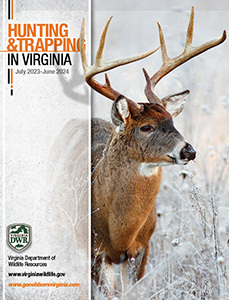Trapping Seasons
There is a continuous open season to trap beaver, muskrat, opossum, and raccoon within the incorporated limits of any city or town in the Commonwealth, and in the counties of Arlington, Chesterfield, Fairfax, Henrico, James City, Loudoun, Prince William, Spotsylvania, Stafford, Roanoke, and York.
When beavers are damaging crops or lands, the owner of the premises, his agent, or tenant, may kill the animals or have them killed. This includes shooting, except in areas where the discharge of firearms is prohibited.
A landowner may trap or shoot fur-bearing animals upon his/her land during closed season when these animals are causing damage to crops or property, or are posing a threat to human health or safety. This provision applies to the landowner only and not his/her agent.
Beaver
December 1 through February 29
Bobcat
November 15 through February 29
All trapped bobcats must be reported within 24 hours through the Department’s electronic harvest reporting system. A CITES tag may also be required for some bobcats. Please see Furbearer Hunting for details regarding electronic bobcat reporting and CITIES tagging procedures.
Coyote
Continuous open season.
Fisher
Continuous closed season.
Fox
Red Fox
November 15 through February 29:
Gray Fox
November 15 through February 29.
Fox (red and gray) trapping is prohibited in Clarke (except on G. R. Thompson WMA), Fauquier (except on C. F. Phelps WMA and G. R. Thompson WMA), Loudoun, and Rappahannock counties.
NOTE: See Harvest Reporting Requirements for gray fox on p. 27.
Mink
December 1 through February 29
Muskrat
December 1 through February 29
Nutria
Continuous open season.
Opossum
November 15 through February 29
Otter
December 1 through February 29
Bag Limit: The season bag limit shall be 4 otters in all counties west of the Blue Ridge. There is no season bag limit in counties east of the Blue Ridge.
CITES Tagging Requirement for Otter
Raw otter pelts and unskinned carcasses that are bought, sold, bartered, traded, solicited for purchase, or transported out of state must have a CITES tag affixed to each animal. No CITES tag is needed to have an otter mounted by a Virginia taxidermist or ship an otter pelt out-of-state for tanning purposes (unless required by the state where the tannery is located). To obtain a CITES tag, the individual harvesting the animal must contact a local Conservation Police Officer through your nearest Department regional office. If an otter pelt is required to have a CITES tag affixed, it must be tagged by April 1 of the season of harvest.
Rabbit
October 15th-January 31st (box traps only). No traps shall be set on another’s land without written permission of the landowner. No license required to box trap rabbits. Live box-trapped rabbits may not be moved outside the county of capture. For rabbits box-trapped for human consumption; all parts not saved for consumption must be disposed of according to regulations described on Small Game Hunting.
Raccoon
November 15 through February 29
Skunk
Continuous open season for striped skunk.
Continuous closed season for taking spotted skunk, and the pelts of spotted skunk may not be sold.
Weasel
December 1 through February 29
Best Management Practices
Sustaining the Future of Regulated Trapping
Trapping in North America is heavily regulated by state and provincial wildlife agencies, providing a critical wildlife management technique used to:
1) capture wildlife for sustainable use by the public,
2) protect property,
3) recover and protect endangered species,
4) manage population levels, and
5) capture animals for scientific research.
Trapping Best Management Practices (BMPs) are carefully researched recommendations designed to ensure animals are humanely captured. Developed as part of the largest trap research effort ever conducted, BMPs feature the latest scientific information about trapping techniques and equipment, along with practical advice from experienced trappers and wildlife biologists. More than 600 types of traps have been evaluated and trapping BMPs exist for 23 different species of furbearers. Help SPREAD THE WORD about BMPs to sustain the future of regulated trapping methods and modern furbearer management.
For more information visit furbearermanagement.com

